The Bagpipe Society
All Fingers and Thumbs
Those musicians whose aim is to evoke with as much accuracy as possible the lost musical world of centuries past are confronted with a formidable obstacle: how to reconstruct conventions of style and tradition that are relevant to a distant era without the added burden of the baggage of subsequent centuries.
Also vital is to take into account the context of the music, where was it played and who played it? What was the purpose of the music, was it social, public, domestic, religious, ceremonial, specifically composed or suggestive of an aural tradition? Much of the information that will help to address these issues is available in the surviving sources of historical documents: manuscripts, municipal records, civic and court account books, literary sources, and eye-witness accounts. Then there is the visual information in painted images and wood and stonework depicting players and their instruments. All these are essential in stripping away later developments and to see the world as it was, and how it differed from that imagined by those who interpret the past through a modern lens.
Historical sources can reveal much about the hierarchy of medieval and renaissance society and how music and its performers fitted into this world.
Music was woven into the fabric of all aspects of society, and at the base of the system were the common, peripatetic entertainers: acrobats, jugglers, travelling players, and minstrels who would move from town to town seeking permission to play at fairs, markets, and other public gatherings. These itinerant performers were viewed askance, associated as they were with vagrancy, begging and disenfranchisement, regarded as a suspicious condition in a society where to belong and conform was fundamental. Then comes what we would now call the *professional * musician, one whose education and training produced a highly skilled and versatile individual whose living was derived from their trade. These musicians were apprenticed to a master and indentured into a livery company, becoming freemen at the end of their apprenticeship, and music as a trade within the structure of civic society was a means of gaining social and economic status.
Shawms, cornetts and trombones [sackbuts], the instruments played by these professionals, were not seen as befitting ‘amateur’ players because of the effort required to sound them, but often non-affiliated minstrels would come into towns with shawms and bagpipes and try to obtain employment in a locale regarded by professionals as exclusively theirs. This led to dispute and eventually to the professional musicians in prominent places such as London, Oxford, Norwich, and Chester, petitioning successfully for the right to control the playing of certain instruments and who could play where. At the apex of the musical world were the court musicians, choristers, organists, and choirmasters.
All the primary source evidence we can find is of course valuable and if interrogated with care can reveal an enormous amount about historical performance and context. However, there is one huge, insurmountable issue that can never wholly be reconciled, being that we simply do not know how the music of several centuries ago sounded. Obviously, there are no recordings but crucially, written references to music are often oblique and present many problems of clarity but more than this is the fact that music was considered in an academic sense as a science. At the emergent medieval universities, the seven liberal arts formed the foundation of an education leading to a degree of Master of Arts and the study of Philosophy. The seven were divided into the quadrivium and the trivium, the four elements of the quadrivium comprising the arts of number: arithmetic - number in abstract, geometry - number in space, music - number in time, and astronomy - number in space and time. The trivium consisted of the study of grammar, logic, and rhetoric. These were the arts of the mind as opposed to the practical arts of medicine and architecture. Thus, by far the majority of writings on music that have survived from the medieval period are concerned with music in the abstract, rather than its quotidian nature. There are very few references to actual music-making, and no significance was given to music as a cultural entity. As the centuries go by, and the humanist renaissance gains momentum, we find more references to secular, earthly music making, and as a result have far more source material on which to rely to gain an impression of the nature of music-making.
And yet, the absence of sound is deafening. The further back in time we look, the less we can see. A considerable number of instruments survive from the sixteenth and seventeenth centuries so with them we can at least recreate with a degree of confidence how they might have sounded [but not necessarily how they were played]. There are also treatises from this later period on the aesthetics of music and how to add ornament and imbue a composition with grace and good taste, but step back two or three centuries and the ground is a lot less firm.
Sources from the Middle Ages are far fewer, constituting a large body of vocal music for church or devotional usage, a considerable number of manuscripts containing secular songs but barely any works that can accurately be identified as specifically for instruments. Before 1400 there are fewer than eighty instrumental works, preserved sometimes within manuscripts of vocal music, in one or two instances in specific collections or even jotted in the flyleaf of a psalter. A few pieces can be identified from the way they are notated as for keyboard but otherwise there is no indication as to what might have played them. Of course, instrumentalists would have played both vocal and instrumental repertoire but due to the predominance of aural transmission, this repertoire, vast and richly varied as it must have been, has disappeared forever.
This absence of crucial information could on one hand be seen perhaps as liberating: without hard and fast rules medieval music could be freely open to any interpretation, and often is, which is why, if you listen to, say, ten recordings of the twelfth century song *Kalenda Maya * by the troubadour Raimbaut de Vaqueiras [fl.1170-1207] made by several early music ensembles, you will encounter wildly differing performances. As well as the instrumentation, the metre of the music can also vary depending on which secondary source the performers is used, and the number of verses sung and how they are pronounced is not consistent. Some of these performances will have been based upon meticulous research and consideration of context, others take a much less rigorous approach, adding a barrage of instruments and percussion and creating elaborate arrangements.
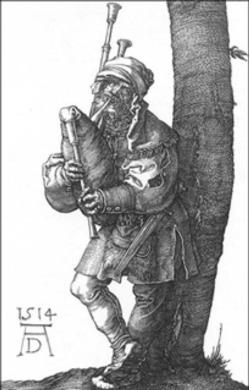
There is also the mistaken assumption that medieval secular music is traditional in the sense of it being ‘folk’ music. Whilst there are perhaps sepulchral traces of a ‘folk’ music in the form of a fragment of popular song used as the basis of a composition, or perhaps the structure of a dance piece bearing traits of folk music heard in our time, the very fact that it is written down in the first place suggests that the origins are not from a folk tradition, rather from a courtly, literary milieu that fostered its own genre and was self-consciously separate from external practices. The blurring of the distinction is increased when instruments from extant traditions are adopted into the performance of early music, for as soon as these are incorporated, there is the distinct possibility that the music will metamorphose into a hybrid, ersatz version of the music from the tradition from which the instrument originates, rather than integrating into a ‘medieval’ sound world, however that may be defined. It is perfectly possible that the modern-day distinction between ‘classical’ and ‘folk’, was not as divergent in the Middle Ages, and likewise that the surviving music from the refined environment of a medieval court was not so far removed from what we might think of as traditional music, but the fact remains that what survives is not directly from a folk tradition.
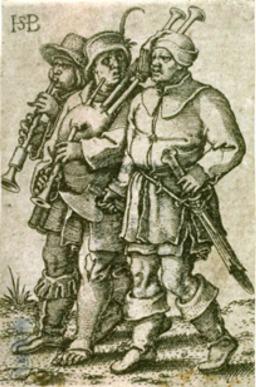
In the British Isles there were bagpipes associated with specific regions the length and breadth of the land. There were extraordinarily varied designs and sizes of pipes, some with single chanter and drone, double chanter, drone and chanter integrated, chanter and no drone. Some images show a drone that descends below the chanter and others have the drone resting on the shoulder, whilst multiple drones either lean forward or rest on the shoulder and sometimes sit under the arm. Bagpipes occur in illuminated manuscripts, murals, carvings and tapestries from all over Europe and, certainly at the earlier part of the period, are to be found in all levels of society, only drifting away from the upper echelons in the later renaissance.
The surviving sources that contain depictions of bagpipes are in the majority not concerned with music per se but represent the instrument in what appears to be its established location: in the open air, playing for al fresco dancing, or for personal entertainment on a rocky hillside with just a dog and assorted sheep for company. In more courtly settings the bagpipes play either solo or, increasingly throughout the Middle Ages, as part of an ensemble usually of mixed loud instruments. Most frequently it is seen in the company of other loud instruments, the shawm, straight trumpet, percussion or with another piper.
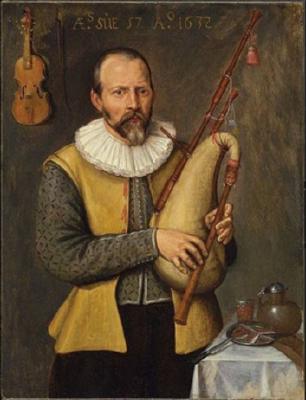
As the years pass by, the pipes slowly disappear from courtly depictions and, other than the occasional ceremonial post of royal bagpiper, assume a role far lower down the social ladder, becoming feature of the bucolic and less rarefied atmosphere of the village green, ale house and at seasonal festivities.
As we move into the latter end of the medieval period and into the early modern, the visual representation of bagpipes becomes more detailed, providing a more dependable source for makers and players to gauge the similarities and differences between instruments of several hundred years ago and today. Of course, the accuracy of a painting is not to be seen as entirely reliable in terms of size and drone types and position but the realism of artists such as Brueghel² and others of the Dutch/Flemish school can give a good idea as to the proportion of the instruments.


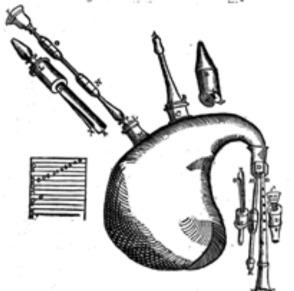
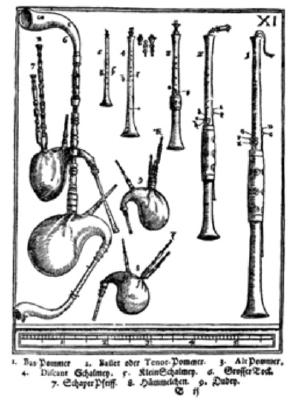
There are examples of some attempt at codifying bagpipes which can be both informative and infuriatingly vague by equal degrees. Sebastian Virdung [1511], Martin Agricola [1529/45], Michael Praetorius [1619??], Marin Mersenne [1636] and James Talbot in the late seventeenth century all give descriptions of instruments, and Praetorius and Talbot [the latter in some detail] give measurements of instruments³.
The so-called ‘Early Music Revival’ gathered real momentum in the late 1960s and continued with dizzy zeal into the ‘70s. In the United Kingdom ensembles such as Musica Reservata, directed by Michael Morrow, St Georges Canzona, and of course The Early Music Consort of London brought the music and instruments of the Middle Ages and Renaissance back to life, lifting them from the murky corners of musicology and onto the concert platform and disc.
These ensembles and the others that followed were inspired by them and encouraged instrument makers to recreate and copy many of the surviving instruments. David Munrow, the charismatic and supremely talented wind player director of the Early Music Consort of London, looked to surviving cultures and traditions to shed light on the sound and techniques of early instruments. At the same time as the rediscovery of early instruments and performance was gathering pace, the folk revival was burgeoning and gaining a foothold in the traditional and rock music worlds with bands such as Pentangle and Steeleye Span forging a brilliant synthesis of folk and popular music. The development of electric folk produced some changes in style from established bands: Fairport Convention on the *Liege and Lief * album nodded towards folk culture and British blues band Jethro Tull produced two albums reflecting an affinity with English folk with the albums *Minstrel in the Gallery * and especially *Songs from the Wood. *
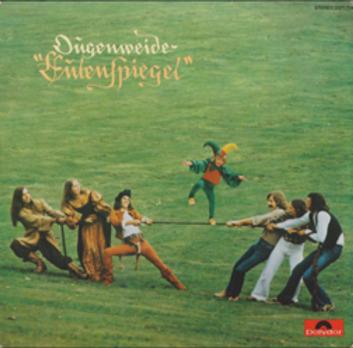
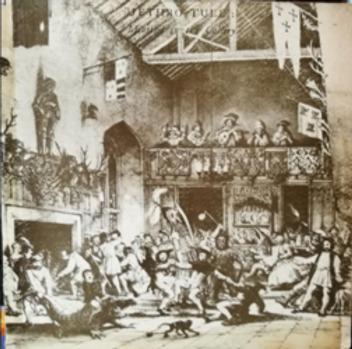
Gryphon, The Albion Band, and other similar bands fuelled the fusion of electronic folk and early music whilst on the continent Ougenweide in Germany produced folk rock incorporating medieval and renaissance instruments. From this parochial bloom came a broader awareness of ‘world music’, the music and traditions of the cultures from without the ambit of the classical west. North African, Asian, Middle and Far Eastern music was now accessible to a growing western audience. Performers of early music, thirsty for any evidence they could glean from manuscript and visual sources seized upon the realisation that much of the practice of traditional cultures could inform aspects of historical performance.
As a result of this embracing of different cultural influences, many performers began to use traditional instruments in the performance of western medieval and renaissance music. David Munrow played a medieval melody on the traditional Galician gaita on his television programme and recording, ‘Instruments of the Middle Ages and Renaissance’. Hand percussion from North Africa and the Middle East was incorporated into performances of medieval music, and the Arabic *oud *[later became becoming the *lute * in Europe] was adopted by ensembles seeking to recreate the sounds of medieval Iberia.
Bagpipes from European traditions were also embraced by early music ensembles. Following Munrow’s lead, the *gaita * was incorporated by groups such as the New London Consort and also my own ensemble, The Dufay Collective in the 1980s. Gradually, throughout the 70s and 80s bagpipe makers began to produce high quality instruments based instruments combined with depictions in historic sources. Jon Swayne and Julian Goodacre led the field in this in the United Kingdom and makers throughout Europe have taken up the mantle and developed historical bagpipe making to a consistently high standard.
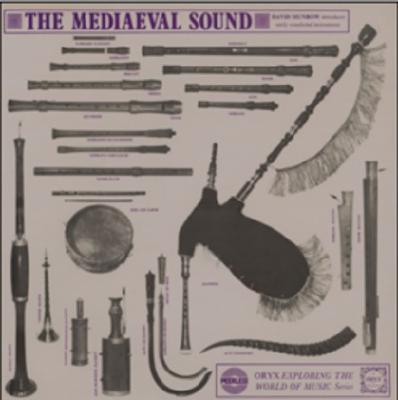
Instrumentalists playing reconstructed medieval instruments often look to the way similar instruments from contemporary folk traditions are played. This process can be extremely revealing and if used to enhance the performance as historical rather than transplant a modern style wholesale, then it can go some way towards finding an appropriate technique. When this approach is used for bagpipes in early music, the myriad variations of type, sound and playing style present on the one hand a hoard of opportunity, on the other a bewildering and confusing question of choice. What sort of bagpipe is appropriate for a particular repertoire, and having finally settled on that, what technique should be used? No bagpipes survive from England from the medieval and renaissance, and no continuous tradition of playing the same type of instrument exists, leaving players having to fill a large gap where a tradition should be.
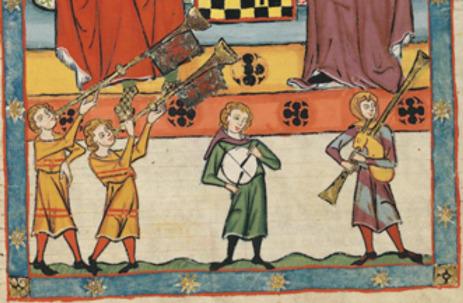
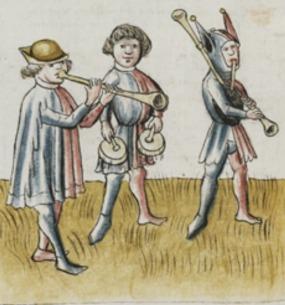
The absence of anything like a representational body of instrumental music from the medieval period need not be seen as an enormous hindrance to finding suitable repertoire to play. The secular monophonic vocal music that survives can be played on instruments, and musicians throughout the medieval and renaissance commonly played instrumental versions of vocal pieces as standard practice. When a medieval dance or song melody has been selected, the next 20 question is what combinations of instruments would be historically appropriate.
There was a relatively rigid convention in the medieval and early modern eras of certain instruments not mixing with others and this generally separated the softer instruments – lutes, vielle, harp, flute, and so on, from the loud shawms, bagpipes, and trumpets. Percussion of various sorts was used, depending on region and period, with both categories. Many of the recordings by ensembles in the 1960s and 70s did not observe this crucial distinction, preferring to blend the sounds of shawms with strings and even voices, or combine lutes, reeds and brass playing together. Including percussion was de rigueur, and became an assumed essential, again contradicting the historical evidence. The arbitrary mash-up of loud and soft continues to be something groups engage in, despite the historical evidence to the contrary.
Bagpipes of course belong in the loud grouping and, assuming that our aspiring early music piper decides on the combination of say bagpipes, shawm, long trumpet and percussion, perhaps in the form of the pair of small bowl drums called nakers [after the Arabic naqari] then they are well set to produce the sound of a medieval wind band. Or are they?
Now that the instruments have been decided upon, other questions arise that are essential in the attempt to recreate an idiomatic performance. The first challenge is to decide the role of each instrument. Perhaps the piece being performed is a monophonic troubadour song from a thirteenth century manuscript of Spanish music. The two melody instruments, the shawm and bagpipe, may play in unison, or heterophonically, but the trumpet has just the notes of the harmonic series, so will have to either play a drone or accompanying part that uses the notes available that concord with the melody. The percussionist can perhaps play a simple beat or improvise more complex rhythms [there is no record of the rhythms played by percussionists until the late sixteenth century].
Now the question of how the two melody instruments will play together arises: bagpipes and shawm are both reed instruments and can have a very similar sound, but they are articulated differently, or are they? The modern assumption is that the medieval shawm was articulated solely with the tongue because it is the ancestor of the oboe, but medieval and renaissance shawms are in the majority depicted with a flat disc or cone shaped support for the lips, the *pirouette. * This same component can be seen on many shawm types in extant traditions and are used when players are circular breathing and using a combination of tongue and fingers to articulate, producing a sound closer to that of the bagpipe chanter. It also supports the lips during prolonged periods of playing. Should the shawm player attempt to assimilate the bagpiper’s technique? Next, should the players consider the cultural history of the piece being played? Large areas of southern Spain had been under Muslim rule since the ninth century so might there have been stylistic elements assimilated from Middle Eastern and north African musical forms? Are modern traditions from these regions altered from how they might have sounded seven hundred years ago? If the two players are using similar techniques, they will be more matched, but then comes the next question: what articulation would the piper use? There is scant indication of elaborate articulatory and ornamental styles from the Middle Ages, apart from an Italian keyboard manuscript from circa 1400 and other vocal music from the fourteenth century. The temptation is to use a style of articulation from a modern tradition and that can certainly work, but again the principal concern must be one of context and of stripping away any ensuing influences. In terms of appropriateness, how historic could it possibly be to use for instance a modern Irish Uilleann piping half-closed articulation when playing a piece from medieval Italy? Perhaps one might think to look closer to home and the tradition of the zampogna and piffero players as an indicator of style. Whilst geographically more apt perhaps, there is the fact that the zampogna are very much rooted in their own tradition and repertoire so do not lend themselves well to other musics.
In fact, iconography of the period in Italy often depicts small or medium sized single drone bagpipes played alone or with a shawm and it is this that should perhaps form the core ensemble for a representative historic performance.
These are just a few examples of the kind of conundrum historical players should address and unless some startling discovery comes to light in the form of a bagpipe treatise from the medieval period or a similarly extraordinary revelation, the sort of speculative enquiry I have outlined is vital in ascertaining the best route towards recreating an idea of idiom for different periods and genres of early music. Finding a sense of style though is essential, and bagpipers wishing to play earlier music in a way that gives it breath and life should strive to find what is appropriate for each repertoire and be as rigorous as possible to produce a convincing and meaningful performance. When a young and impressionable newcomer, I once asked a seasoned pro what articulation he used on the medieval pipes he was playing. The response was: ‘Oh, I just waggle my fingers about, dear boy’! Let’s hope we have moved on a little further from that approach.
¹ William Lyons. ‘Piping Down, The changing status of the bagpiper from the 12th to the 17th centuries’, Chanter, vol. 35. No. 1 Spring 2021
² Pieter Brueghel the Elder [c.1525-1569]
³ Sebastian Virdung, Musica getutscht und ausgezogen (Basel, 1511), Martin Agricola, Musica instrumentalis deudsch [(Wittenburg 1529), Michael Praetorius, Syntagma Musicum, vol.2 Theatrum Instrumentorum, (Wolfenbüttel 1619) Marin Mersenne, Harmonie Universelle, (Paris, 1637) James Talbot, Christ Church Library, Oxford, MS. 1187 (c.1685-1700)
- Data Processing Notice (GDPR)
-
@BagpipeSociety on X (formally known as Twitter)
-
TheBagpipeSociety on Instagram
-
 BagpipeSociety on Facebook
BagpipeSociety on Facebook
Something wrong or missing from this page? Let us know!
